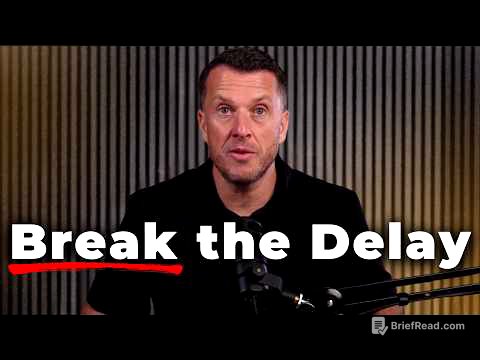TLDR;
This video discusses the importance of morning routines, drawing from Hal Elrod's "The Miracle Morning" method. It highlights the routines of successful individuals, emphasizing that a structured morning can significantly impact one's life. The video outlines six key morning habits: meditation, affirmations, visualization, exercise, reading, and journaling. It also addresses common questions about implementing these routines, such as what to eat for breakfast, how to adjust the routine for night shift workers, and tips for waking up early.
- Successful people often have structured morning routines.
- Hal Elrod's "The Miracle Morning" method includes meditation, affirmations, visualization, exercise, reading, and journaling.
- The video provides practical tips for implementing and customizing these routines.
Introduction to Morning Routines [0:00]
The video starts by highlighting the popularity of morning routine videos on YouTube, both in Japan and internationally. These videos often feature successful individuals and their daily habits, with viewers hoping to glean insights into their success. Many successful people, such as Jack Dorsey, Jeff Bezos, Howard Schultz, and Tim Cook, are known for waking up early and following specific routines. The video aims to provide actionable steps for creating a transformative morning routine based on Hal Elrod's "The Miracle Morning" method.
Hal Elrod's Story [2:16]
The video introduces Hal Elrod, the author of "The Miracle Morning," and recounts his life story. At 20, Elrod was a successful top salesman but suffered a severe car accident caused by a drunk driver, resulting in multiple fractures and brain damage. He was clinically dead for six minutes but survived, and doctors initially said he might never walk again. Despite this, he recovered, returned to sales, and had his best year. Later, during the 2008 financial crisis, he faced a $4 million debt and depression. Elrod turned his life around by developing the "Miracle Morning" routine, which helped him overcome his debt and achieve significant success.
The First Three Morning Routines: Mindset [5:20]
The first of the six morning routines is meditation. The video emphasizes its growing popularity among successful individuals and major companies like Google and Apple. Meditation can improve focus, reduce stress, and enhance memory. The video recommends viewers to check previous videos for detailed instructions. The second routine is affirmations, which involve repeating positive statements to program the subconscious mind. The video addresses skepticism by highlighting the power of words and the influence of external opinions on self-perception. It cites examples like Muhammad Ali, who used affirmations to achieve his goals. The recommended approach is to vocalize or internalize your goals with specific numbers and deadlines. The third routine is visualization, also known as imaging, which involves creating a mental picture of your ideal self and day. By vividly imagining a successful day, you can program your brain to move towards that reality. Successful figures like Bill Gates, Tiger Woods, and Will Smith use visualization.
The Next Three Morning Routines: Action [10:18]
The fourth morning routine is exercise. It doesn't need to be intense; the goal is to raise your pulse and energize your body. Hal Elrod suggests that even a few minutes of exercise can boost energy levels, improve health, stabilize emotions, and enhance focus. Activities like yoga, walking, jogging, or going to the gym are all suitable. The fifth routine is reading. Hal Elrod recommends reading at least 10 pages of a book each morning. The key benefit of morning reading is the ability to immediately apply what you learn. Even a small amount of reading can provide valuable insights that can be put into practice during the day. The sixth routine is journaling. This involves writing in a journal to accelerate personal growth. Keeping a record of your thoughts, goals, and progress can be highly beneficial. It increases motivation, clarifies priorities, and stimulates further growth. Hal Elrod suggests writing about things you are grateful for, achievements, areas for improvement, and specific actions to take.
Implementing the Morning Routine [14:27]
The video explains that the six morning routines should take a total of 60 minutes. Hal Elrod's suggested breakdown includes 5 minutes for meditation, 5 minutes for affirmations, 5 minutes for visualization, 20 minutes for reading, 5 minutes for journaling, and 20 minutes for exercise. However, these times can be adjusted to fit individual preferences. For those with limited time, a 6-minute version is recommended: 1 minute of silence (meditation), 1 minute of affirmations, 1 minute of visualization, 1 minute of writing (journaling), 1 minute of reading, and 1 minute of exercise.
Additional Tips for a Successful Morning [16:32]
The video addresses common questions about the morning routine. Regarding breakfast, Hal Elrod suggests eating as light as possible to avoid digestive strain and maintain focus. He recommends a smoothie made with water, almond milk, banana, and frozen berries. For those who work night shifts, the routine doesn't necessarily need to be done in the morning; it can be done whenever you wake up. To wake up early, focus on your mindset before bed. Instead of thinking about how little sleep you're getting, appreciate the sleep you will get. Also, drink a glass of water immediately after waking up to combat dehydration and fatigue.
Conclusion [21:23]
The video concludes by reiterating the transformative potential of a consistent morning routine. Successful individuals prioritize their mornings, and the cumulative effect of these habits can lead to significant positive changes over time. The video encourages viewers to commit to improving their morning routine and to persevere even when it feels challenging.









